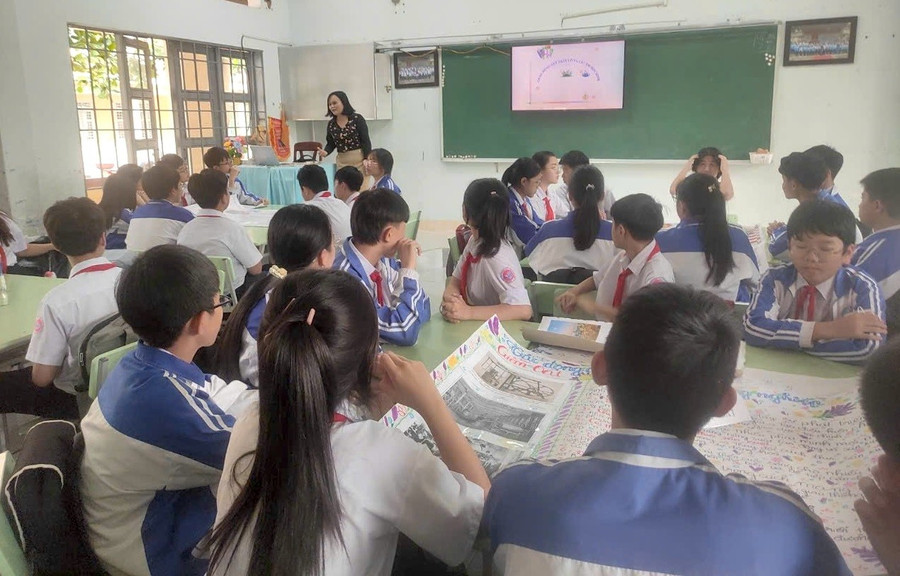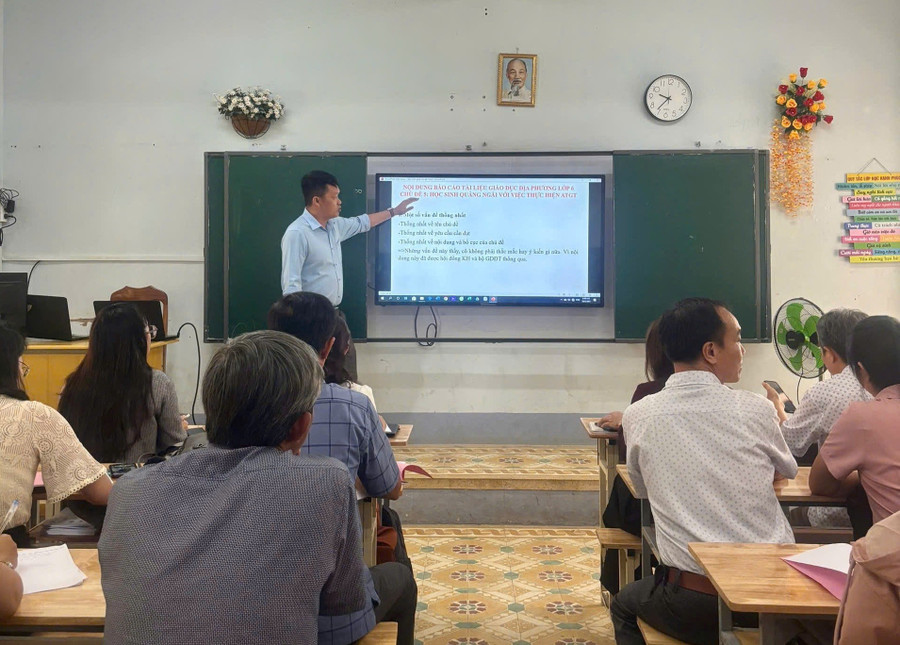Teachers and schools proactively integrate cultural, historical and geographical knowledge, helping students both acquire knowledge and foster pride in their new homeland.
Integrate to avoid “breakage”
After Kon Tum and Quang Ngai merged into Quang Ngai province, many contents in the local education program need to be adjusted to suit the new context. This is both a challenge and an opportunity for the education sector to enrich the lessons, helping students access and experience more widely the culture, history and geography of the two regions.
Ms. Huynh Thi Thu Van - Head of the Preschool and Primary Education Department of the Quang Ngai Department of Education and Training, said: Recently, the department organized training for key staff and teachers on the use of GDDP materials in the 2025 - 2026 school year. The highlight of the training session was to introduce how to select teaching content by topic, while integrating cultural values, landmarks, and historical relics of both former provinces.
“We determined that using documents from Kon Tum and Quang Ngai in parallel during this period is necessary, so that the curriculum is not interrupted. Teachers can choose appropriate content, arranged by topic to highlight the diversity and richness of the locality after the merger,” Ms. Van shared.
While waiting for the Ministry of Education and Training to issue official instructions, the Department of Education and Training of Quang Ngai will advise on the establishment of a new document compilation team based on the merger of the two previous compilation teams of Kon Tum and Quang Ngai. The compilation will ensure continuity, while maintaining unique characteristics and creating a unified set of documents for students across the province.
Along with adjusting the documents, the Education sector also encourages schools to organize experiential activities related to the locality. Students can visit relics, craft villages, and festivals to directly experience, instead of just learning through books. This is an opportunity for teachers to practice “open education”, helping students understand that their homeland not only has a glorious past, but is also changing every day.
Ms. Van emphasized that for the content about population and culture, teachers need to proactively supplement knowledge during the teaching process, explain the differences between the two regions, thereby arousing the spirit of solidarity and attachment.

Proactive empowerment
Mr. Pham Dinh Kha - Head of Secondary Education Department, Department of Education and Training of Da Nang said that in August, the department completed the construction of the system of topics for the Local Education Documents for junior high school and high school levels of Da Nang city, based on the selection and consolidation of topics from the Local Education Documents of Quang Nam province (old) and Da Nang city (old) from grade 6 to grade 12, approved by the Ministry of Education and Training from the 2021 - 2022 school year.
Based on the unified topic system, units and schools assign professional groups and teachers to compile the content of each topic. For each level of education, the Department of Education and Training of Da Nang sends along suggestions for compiling unified topics, some new topics and old GDDP documents for schools to refer to.
When building a new subject system, it is inevitable to change the order of subjects in each class, between classes and levels compared to the old documents. According to Mr. Kha, in the process of teaching new subjects, there may be situations where students relearn some subjects because they have learned them in the lower class of the old documents, or have not learned some subjects because they have moved to the lower class of the new documents. Therefore, units can proactively change the order of subjects, integrate and supplement appropriate content to ensure continuity and promote educational effectiveness.
Based on the post-merger GDDP topic system, teachers at Nguyen Hue Secondary School (Hai Chau, Da Nang) have been actively adjusting and supplementing documents to suit the new situation.
Mr. Nguyen Van Tuan - Head of the History - Geography group (Nguyen Hue Secondary School), shared: Teachers of the subject of Local Education have two main tasks. First, update the names of new administrative units, with notes on the old names so that students can easily absorb them. Second, develop teaching plans and organize teaching. Teachers review the unified topic system, re-compile lessons according to the standard structure, and include new places and relics in the education plan, lessons, extracurricular activities and experiences. Teachers are empowered to proactively swap the order of topics and integrate knowledge to avoid duplication or omission of content from old documents.
Mr. Pham Tan Ngoc Thuy - Deputy Director of the Department of Education and Training of Da Nang, emphasized that teachers need to study new data and documents on socio-economics, Party congress documents, new relics and titles, statistics, etc. to adjust and supplement information accurately and promptly.

Creativity to enrich lessons
At Ly Tu Trong Secondary School - Pedagogical Practice (Quang Ngai), after sending 6 key teachers to participate in training, the school quickly deployed instructions for all teachers. Based on the directive documents of the department, the school built a plan for teaching and learning local education in each field, encouraging teachers to diversify the forms of organization.
Principal Pham Duc Phuoc said that with History, teachers can dramatize lessons so that students can transform into historical figures; implement projects, make models, videos, and exhibitions about events such as the Ba To uprising and the Ba Gia victory. Teachers can also organize history games using Quizizz, Kahoot, the board game “Road to Quang Ngai”, or set up a “mini museum” right in the classroom.
In the cultural field, students perform gong - xoang, ly - ho singing, dance of the Hre, Cor, Ba Na people; collect folk tales; participate in the "Local Cultural Festival" with traditional costumes and culinary specialties. Other subjects such as Literature, Fine Arts, and Music are also integrated to enrich the experience.
In terms of geography and economics, students learn through Digital Maps, carry out projects on “Quang Ngai’s Sea and Island Economy”, “The Role of Dung Quat Economic Zone”, or learn about the Sa Huynh salt industry. The game “Quang Ngai Economic Map” helps match districts with prominent products.
Career guidance and socio-political issues are also emphasized. The school organizes experiences at vocational facilities, invites former students and parents to share; students play the role of veterans, mothers of martyrs, and youth volunteers, write letters of gratitude, draw maps of martyr cemeteries, participate in charity work, and take care of heroes' graves.
“The merger of two provinces is not only an administrative event, but also opens up opportunities for the young generation to access a rich treasure trove of local knowledge, fostering pride and a sense of responsibility for their new homeland,” said Mr. Phuoc.
In Gia Lai, after merging with Binh Dinh, teachers have also proactively sought to enrich their lessons. Ms. Pham Thi Thien - Nu 2 school, Cu Chinh Lan Primary School (Ia Chia, Gia Lai), shared: While waiting for specific instructions from the department, the school and the professional team have proactively sought to flexibly teach GDDP.
Right in the first lesson of History - Geography for grade 4 with the topic "My locality", students were introduced to new knowledge: The whole country now has only 34 provinces and cities instead of 63 as before. In Gia Lai, after merging with Binh Dinh, the area, population and local culture have all changed and become richer. Students learned more about Binh Dinh culture such as bai choi, tuong art along with gongs and xoan dance of the Central Highlands.
“Teachers must be flexible and update their knowledge to both convey the correct information and inspire pride in regional cultural diversity. For children living in the border areas, this is not only new information, but also opens up curiosity about the larger country,” said Ms. Thien.
In addition to updating cultural and social knowledge, during the summer, teachers are also trained in digital skills, exploiting digital space and applying artificial intelligence (AI) in teaching. This is not only a provision for teachers, but is also integrated and introduced to students, encouraging them to approach and use technology in a positive and safe way.
The Department of Education and Training of Da Nang instructs schools: In adjusting the GDDP documents, it is necessary to update and use the names of administrative units in accordance with current regulations (communes, wards, special zones, cities, etc.), and at the same time, connect the old names and old localities so that teachers and students can easily absorb them. In topics about historical periods, historical figures, celebrities, etc., it is still necessary to use the old local names (place of birth, place of death, place of office, campaign, battle, etc.) and annotate and connect the new names.
Source: https://giaoducthoidai.vn/day-hoc-giao-duc-dia-phuong-sau-sap-nhap-kien-tao-ban-sac-moi-cho-the-he-tre-post748261.html


![[Photo] Prime Minister Pham Minh Chinh attends the 5th National Press Awards Ceremony on preventing and combating corruption, waste and negativity](https://vphoto.vietnam.vn/thumb/1200x675/vietnam/resource/IMAGE/2025/10/31/1761881588160_dsc-8359-jpg.webp)

![[Photo] Da Nang: Water gradually recedes, local authorities take advantage of the cleanup](https://vphoto.vietnam.vn/thumb/1200x675/vietnam/resource/IMAGE/2025/10/31/1761897188943_ndo_tr_2-jpg.webp)








































































































Comment (0)